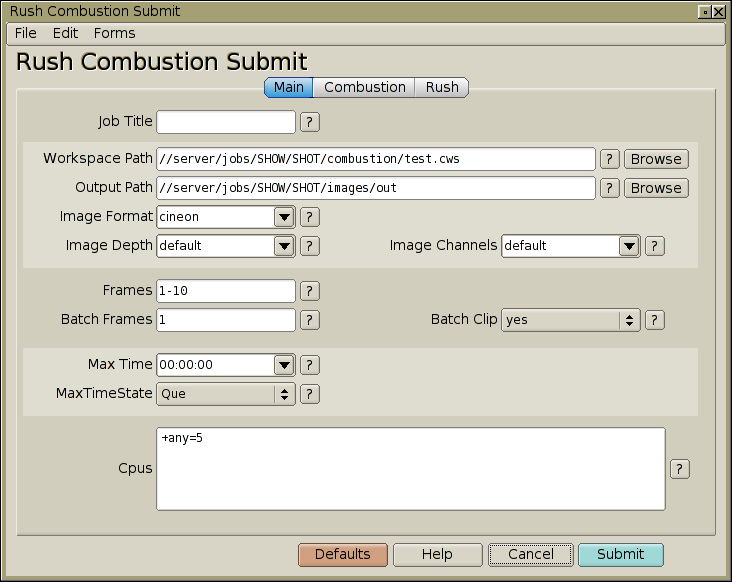Please send bug reports to



This should have already been set up by your sysadmin, or the person who installed the rush software:
This script will be executed not only by the user to bring up the submit-combustion GUI, but it will also be executed on all the render machines to run the renders.
To ensure the renders run with the proper environment, you'll need to modify these lines at the top of the script:
### COMBUSTION SPECIFIC VARIABLES -- CUSTOMIZE AS NECESSARY ###
### See Discreet's documentation for more info. ###
if ( $G::iswindows )
{
# WINDOWS
$ENV{PATH} = "c:/program files/discreet/combustion 4;$ENV{PATH}";
}
elsif ( -d "/Applications" )
{
# OSX
$ENV{PATH} = "/Applications/Discreet/Combustion/bin:$ENV{PATH}";
}
else
{
# LINUX
$ENV{PATH} = "/usr/discreet/combustion/bin:$ENV{PATH}";
}
|
Be sure the shortcut points to a copy on a file server, and not to local files in c:\rush\examples (windows) or /usr/local/rush/examples (unix).
Should be as simple as clicking on your desktop shortcut.
If you prefer using a terminal window, be sure to run the script with an absolute UNC path, eg:
perl //server/jobs/rushscripts/perl/submit-combustion.plIf you don't run it with an absolute path, the frames will fail because rush didn't have the absolute path to the submit script.
The interface should pop up. If it doesn't, verify (unix) the first line in the script's path points to the correct location of your perl binary, or (windows) the '.pl' extension is configured to correctly invoke perl.
Click the help button (buttons with '?') for any field you want to know more about.
When the GUI pops up, note there are various 'Advanced Options' available if you scroll the window down.
For the Worksspace Path, navigate to your .cws file using the Browse button. If it is your first time submitting, you may have to manually type in the //server/volume name in order to get a directory listing.
Avoid using a mapped drive letter (z:/yada/yada) to get to your cws file to avoid problems with drive maps, eg. when people log out, and the drive maps disappear.
Set the Output Path to the directory where you want the images to be written to. Include the filename followed by a dot (.), as this is the syntax Combustion wants you to use.
So for instance, if you specify:
//server/jobs/honda/images/sc17-bg...and have the "Image Format" set to 'cineon', this will result in files being rendered as:
//server/jobs/honda/images/sc17-bg.0001.cin //server/jobs/honda/images/sc17-bg.0002.cin ..
This is the image format for the rendered images.
This is the range of frames you want to render; normally two values separated by a dash, eg. '1-100'.
You can also specify individual frames, multiple ranges, or cobinations of both, eg. '1 10 20-30 400-900', which would render frames 1, 10, 20 through 30, and 400 through 900.
In our case, lets use any 5 available cpus at the lowest priority:
+any=5@1
Scroll down to look over the 'Advanced Options'. For instance the 'Combustion Flags' prompt lets you pass extra command line arguments to Combustion's 'shellrenderer' command line; see 'shellrenderer -help' for more info.
Also, various other seldom changed flags, such as Field Dominance, and other options are available.
Click the help button (buttons with '?') for any field you want to know more about.
This should submit your job, and a window indicating the jobid should pop up, followed by an irush interface with the jobid already set to the new job.
The next time you bring up the submit form, it will have all the values set from the last execution. Note that you can then save this as a form so you can easily recall it later.
For more info on the irush interface, see the irush tutorial.
Hit 'Frames' in irush to watch the progress of your job.
If some frames are running, or got done already, click on
some, and hit 'Logs' to see the output of the perl commands
you entered.
When you're finished with the job, hit 'Dump' in irush.